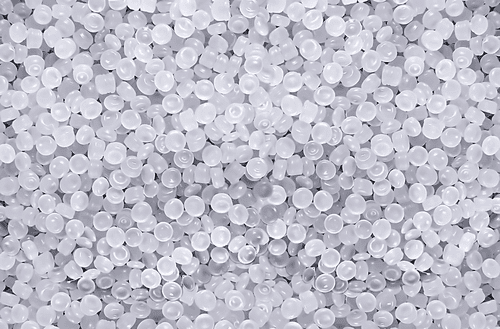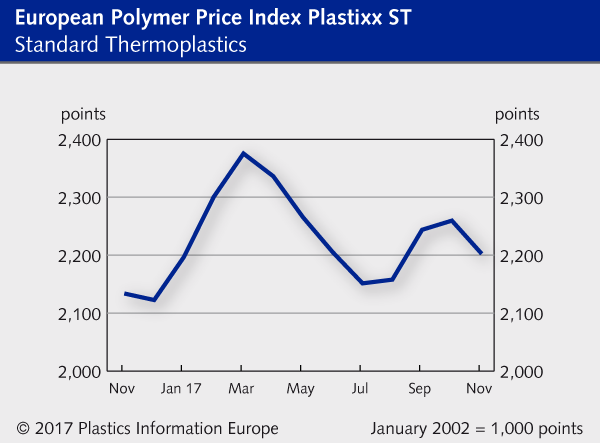
Polymer Price Reports Released for November 2017
The latest polymer price reports and charts have been released by Plastics Information Europe (PIE).
Standard Thermoplastics November 2017: Polyolefins give way / PVC stable / PS follows precursor downwards / PET goes into descent / Olefins going up in December / Cost transfer not clear / Styrene rockets
PE: European PE producers had certainly expected November to pan out differently than it did. Following the rollover of the ethylene reference price, some of them had been hoping to push through increases. Instead, all kinds of lock gates opened: material streamed on to the market due to stock-cutting measures, considerable volumes arrived from central European countries and intercontinental imports were also lively. First offers from the new US production plants also put in an appearance – something that is likely to cause European producers a headache in the longer term. It was thus inevitable that the hoped-for price rises would be impossible to achieve. In turn, the lower-than-expected prices induced many buyers to top up their inventories as costs could turn around at any time. The net result was that price reductions in many areas remained moderate.
As expected, the ethylene reference price for December has risen by EUR 32/t, causing one producer to call for hikes of EUR 70/t. Others were said to be seeking a rollover or even offering price cuts again. Consequently, any price increases are unlikely to be very large. Buyers are under no pressure as they purchased at a lively rate in November and the low-production Christmas season is now imminent. The most likely scenario is therefore a rollover, and the usual strong offensive by producers in January. Maybe the New Year will bring them more luck.
PP: Weak demand in October left PP producers sitting on excess inventory, so that many of them needed to offload material. As a result, in the first two weeks of the month especially, the supply side offered rebates as a stimulus to buy. With rising oil and naphtha notations on the horizon, converters gladly took the bait and ordered. Toward the end of November, buying activity tapered off, however. While PP prices in general sank, compound notations rolled over as the rebates offered were too weak to create much impetus to buy.
After the OPEC conference on 30 November did not produce the desired impetus, the fixing of the propylene reference contract EUR 32/t higher paid tribute to the rising cost of naphtha. Of course, producers want to pass on the cost rise plus a margin component. In December, when demand is traditionally weak, they may find the going tough – especially as many buyers stocked up in November at lower prices. By contrast, buyers of compounds will surely have to swallow their suppliers’ cost rise in full.
PVC: The stagnating ethylene reference contract set the example with a rollover, and European PVC markets then followed suit for the most part in November 2017, although a number of segments, including profiles, cables and films, recorded a striking level of activity. This made up for the calmer situation that prevailed in other sectors like pipes business.
Compounds remained constant this time round, as did the base and paste grades. Cost increases for additives such as titanium dioxide, impact modifiers and plasticisers took a break. Mixers and compounders also reported brisk demand, however. It was reported in many places that lines were running at full capacity.
A preview of the order situation points to exceptionally brisk activity in December too. In response, compounders have already announced that their production lines will be running between Christmas and New Year. Despite this, demand will doubtless calm down over the festive season. How far suppliers will succeed in translating the upward pressure exerted by ethylene into prices rises remains to be seen. Soft compounds would seem to be most receptive to this, since the plasticiser chains are also emitting buoyancy signals again.
Styrenics: After the renewed decrease of the SM reference contract in November, prices for the entire range of styrenics followed suit. Discounts on PS and ABS largely corresponded to the cost reductions. EPS suppliers, however, could leverage the tight supply situation to expand their margins. There was thus a broad range of price changes, ranging from weak rollovers to nearly full transfers of cost reductions.
After two months of declining prices, styrenics prices trended upwards again in December. The new trend was set by the SM reference contract, which increased by EUR 95/t in the last month of the year. For ABS, butadiene costs went down by EUR 100/t and limited the hikes; however, EPS will surely see a reflection of continued short supply in all price agreements. Styrenics prices are also likely to see a lasting upward trend in the first months of 2018 because several maintenance shutdowns will limit SM availability.
PET: A noticeable reticence on the part of purchasers, coupled with brisk import activity, prompted clear reductions in PET prices in the course of November 2017. Notations at the end of November were, on average, around EUR 80/t below those of two months earlier. The peak phase of PET prices during the summer thus proved to be a short-lived flash in the pan. The familiar structural problems associated with global overcapacity returned with a vengeance. Chinese goods increasingly infiltrated Europe, with considerable quantities arriving in Italy, in particular. At the same time, demand remained at a low level.
Prices are under pressure again in December. Virtually no momentum is evident on either the supply or demand side that could prompt a change. Costs could rise on account of the increase in oil prices. This will be of little use to producers here, however. Margins could suffer once again.
Engineering Thermoplastics November 2017: Fresh price rally in the offing / Initial rises for nearly all types / Supply becomes tighter / Increasing feedstock costs will drive prices up further in December
It seems that November witnessed the start of a fresh price rally on the European market for engineering thermoplastics. Sometimes it was due to rising international notations for feedstocks and intermediates for the classic engineering materials, and sometimes it was down to insufficient compounding capacities. Buyers clearly became nervous in many areas and initial customer allocations and reports of rising prices in the oil and refinery chains induced many of them to make purchases to keep in reserve – provided material was still available. ABS prices have since declined due to the marked fall in the cost of SM, while PP compounds are stuck in a rollover.
Against this background, indications point to an unusually “hot” December. Producers are expected to announce significant increases, and benzene in Europe has now also reacted to strong demand from North America and Asia. The reference price rocketed by EUR 145/t. This hefty leap is bound to boost producers’ resolve to factor in at least part of their planned increases before the end of the year.
Buyers’ nervousness plus the continuing strong demand in many end-market segments are generating plenty of interest. Although things will naturally quieten down over the bank holidays, it will not be enough to dampen demand sufficiently to prevent price hikes. ABS and PP compounds are also on the up. Furthermore, a look at the first quarter in 2018 offers little prospect of the tension easing. On the contrary, further rises are expected. The world markets are in increasing turmoil.
For more than 34 years, PIE has been an invaluable source of information for European plastics industry decision makers – a quick, yet in-depth look at the development of plastics markets and polymer prices. Available online 24/7 and as a printed newsletter twice a month. To read the entire report, go to www.pieweb.com and sign up for a 48-hour free trial!







